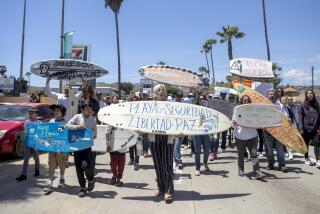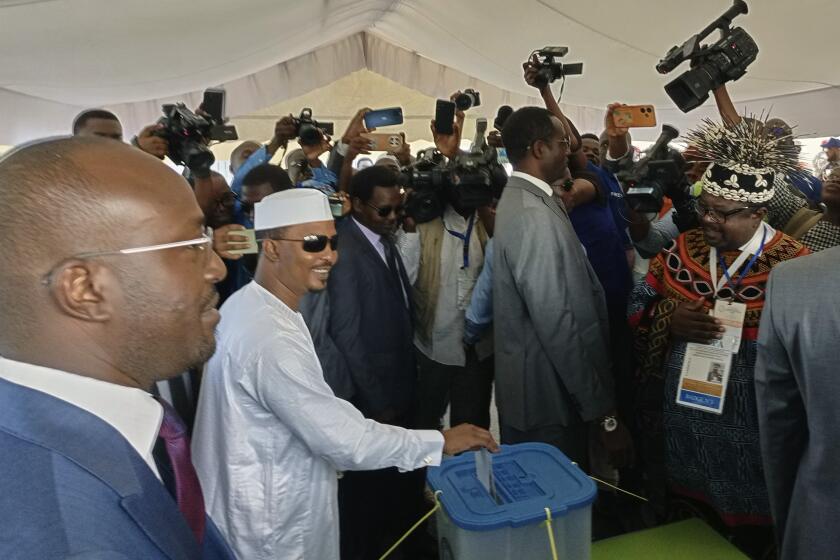Division of the Charity Dollar Is A-Changing : Under Study’s Scrutiny, Those Aiding Poor Gain at Expense of Alternative, Advocacy Groups
Turn the light of scrutiny on foundations and corporations when they slice up the philanthropic pie and they slice it differently than when no one is watching.
That’s the lesson from a pioneering examination of grants awarded by Minnesota’s 40 largest philanthropic endowments and corporate giving programs.
The study findings, and their effect on foundation and corporate giving patterns, hold important lessons applicable nationwide to charities interested in encouraging philanthropic endowments to be more responsive to the needs and concerns of the economically disadvantaged.
Where the Gifts Go
By law, foundations and corporate giving programs must make gifts only to charitable organizations, government agencies or, in some cases, to individuals to support projects benefiting the public.
More than 100 Minnesota charities serving the economically disadvantaged created the Minnesota Philanthropy Project to examine what share of the charity pie benefits the poor, minorities, women and the handicapped.
Since 1982, the first year of grants studied, the share going to these interests in Minnesota has grown by nearly one-third. Meanwhile, the share going to rural and nontraditional charities and advocacy organizations got smaller.
Studies of charitable giving usually limit their examination to such rudimentary factors as how grants are divided among the broad categories of education, health care, the arts and human services.
The Minnesota Philanthropy Project, however, dug far beyond this in its 42-month study, delving into the more subtle--and enlightening--question of who benefits from foundation and corporate giving. The results of the final study were the subject of a recent conference here on “Minnesota Philanthropy and the Disadvantaged.”
The project, which will close at year’s end, began more than three years ago when leaders of poor peoples’ charities met to discuss their problems. “We talked about how we would get checks for $500 or maybe $1,000 while foundations gave hundreds of thousands of dollars to other nonprofits,” said Joe Selvaggio, executive director of Pride in Living, an alternative to public housing for the poor. So the nonprofit officials decided to conduct a study.
To dramatize the study findings, the Minnesota Philanthropy Project baked a two-foot diameter charity pie. Surrounded by TV cameras, James Shannon, president of the General Mills Foundation and former chairman of the Council on Foundations, the national trade association for philanthropic endowments, cut a slice equal to 38.1% of the pie, representing the share of grants studied that went to charities serving the economically disadvantaged in 1985.
“We’ve changed the definition of what a good foundation is,” said Jon Pratt, 34, the director of the Minnesota Philanthropy Project. “How good a foundation is used to be judged by how much money it gave. But to the foundations themselves, and in the public’s mind here, we’ve changed the definition of a good foundation to issues of who benefits from those gifts.”
The project examined more than 20,000 grants made in 1982 and 1984. In 1985 the project studied nearly 13,000 grants, totaling $146 million, made by Minnesota’s 40 largest foundations. The 1985 grants studied equalled 69% of all grant monies awarded by all Minnesota foundations and corporations last year.
Poor’s Share Grows
The study showed that in 1982, charities serving the poor, women, minorities and the handicapped got 28% of the grant monies studied. By 1984, after the first survey results had been privately distributed to the funders, this rose to 30%. In 1985, the study showed, $55.6 million or 38.1% of the grant monies awarded went to charities serving the economically disadvantaged.
Terry Saario, president of the Northwest Area Foundation here with $180 million in assets, said that because of the increase in the number of poor people in the ‘80s her foundation would have given more to charities serving the economically disadvantaged regardless of the study. “The Philanthropy Project’s presence and the questions they ask force you to be a little more self-conscious about who are the beneficiaries of grants,” Saario said. “The study also created a climate in the Twin Cities foundation community that legitimized greater concern for the poor.”
But General Mills Foundation’s Shannon said the overall increase in foundation giving to charities serving the poor was also due to public disclosure of the study results which “held some feet to the fire.”
“It is frequently implied that much of philanthropy goes to the neediest members of society,” the final study states. But the study results challenge this notion, especially before changes in giving strategies that were encouraged by public disclosure of the study.
“This is not a perfect instrument, but this is a very good study,” said Shannon. He noted that many foundations worked with the study staff in determining how to categorize their grants to make it accurate.
The Twin Cities are widely regarded in philanthropic circles as having perhaps the most thoughtful and generous donors of any U.S. metropolis with many corporations belonging to clubs that pledge to give to charity 5% or 2% of their pretax profits. The national average for corporations is about 1% of pretax profits, with a significant minority of corporations making no charitable gifts or almost none at all.
The Minnesota Philanthropy Project initially circulated its first study privately as part of a strategy to win the cooperation of foundation staffs and trustees and corporate giving officers for the second and third studies. The three studies, which cost $120,000, were 80% funded by foundations and corporations with the balance coming from individuals and the charities that organized the studies.
Federal Funding Cuts
Pratt said interviews with foundation officers and corporate givers during the study show that giving to the poor also increased because of the cuts in federal spending for charities serving the poor.
Most grants to the poor are to provide services that supplement or operate in lieu of government programs. Just one dollar in 25 given to help the poor and disadvantaged here goes to advocacy charities even though such charities, when their efforts succeed, can leverage grants into vastly greater sums by making systemic changes that benefit the poor.
“A disturbing finding of the Philanthropy Project study is that decline in grants to advocacy groups,” said Pablo Eisenberg, executive director of the Center for Community Change in Washington, which provides technical assistance to grass-roots charities organized by poor people. “At a time when government and the public seem less sensitive to the needs and desires of low-income people, there is a greater need than ever for support to organizations fighting to help self-help nonprofits and to bring about changes in the conduct of both private and public institutions.”
Additional features in View Part I and Part III.
More to Read
Start your day right
Sign up for Essential California for news, features and recommendations from the L.A. Times and beyond in your inbox six days a week.
You may occasionally receive promotional content from the Los Angeles Times.






